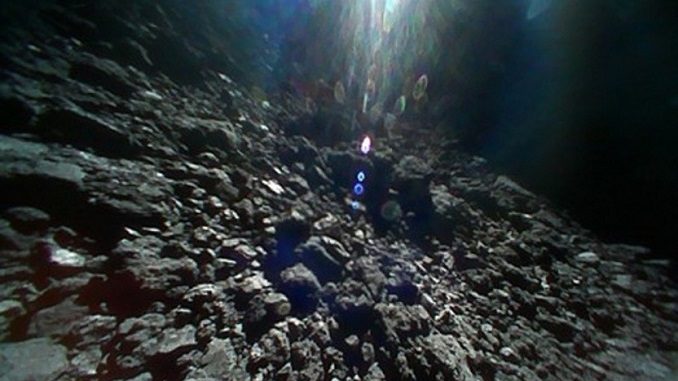
It was a brief but historic tap on the surface of the asteroid Ryugu, at 7:29 am Japan time on 22 February. The Hayabusa2 spacecraft touched down at its target location, where it shot a projectile at the surface. The probe then began ascending to its ‘parking’ altitude, the Japan Aerospace Exploration Agency said in a series of tweets. The mission team is now waiting to confirm whether the spacecraft collected a sample from the space rock, Nature reported.
If successful, it will be only the second time in history that a probe has collected a sample from an asteroid, after a predecessor mission, Hayabusa, did so in 2005. The manoeuvre was considered one of the high-risk highlights of this mission — Ryugu’s surface is strewn with boulders that could damage the craft. The mission aims to return samples of asteroid material back to Earth at the end of 2020 for study.
“The touchdown has progressed very smoothly,” said Satoshi Hosoda, from the Japanese space agency JAXA, in a webcast. “Those people who were involved were very tense but then we saw nice smiles and they were all hugging each other.”
Yuichi Tsuda, the mission project manager, later confirmed at a press conference that the sequence for the projectile firing to collect samples had happened as planned.
As the probe gently touched down, a bullet fired into the surface, kicking up sand, pebbles and fragments of rock into a collection chamber, called a sampler horn. If this failed, the horn has teeth that can raise surface material to the probe.
Hayabusa2 began its slow fall towards Ryugu around 26 hours earlier, starting from an altitude of 20 kilometres, where it had been hovering. (Ryugu’s weak gravity means it is difficult for objects to remain in orbit around it.)
The spacecraft autonomously guided its descent, ready to abort by gently pushing itself upwards if any anomalies were to occur. As the asteroid’s surface slowly rotated below it, Hayabusa2 locked onto a ‘target maker’ — essentially a small, reflective beanbag it had previously deployed to the surface, Nature writes.
Mission scientists had dubbed the target location L08-E1. They had selected it as one of the ‘least bad’ options on the asteroid, which is almost entirely covered with rocks of varying sizes. Hitting a boulder during a touchdown manoeuvre could have disastrous consequences for the mission, Nature adds.
Hayabusa2 launched in late 2014 and arrived at Ryugu — an object only 1 kilometre wide in an orbit not far from Earth’s — in June 2018. JAXA then mapped the surface in detail, and later selected the sites for a multi-pronged assault on the space rock. The mothership craft has already released three small probes onto the surface, from where they beamed back pictures in September and October.

Be the first to comment